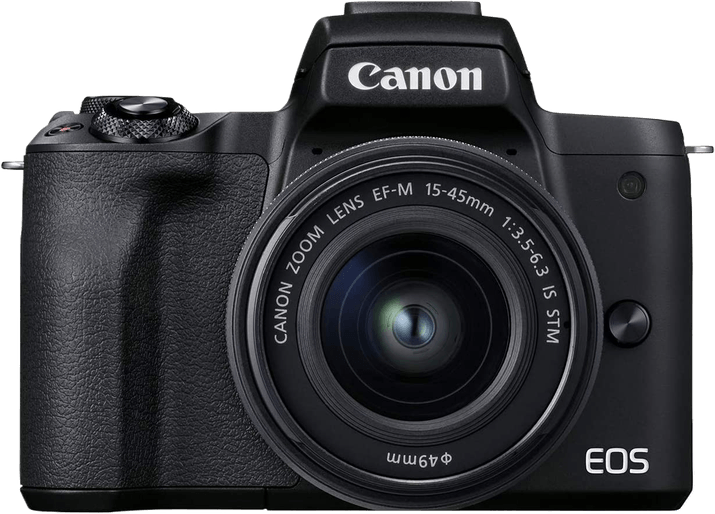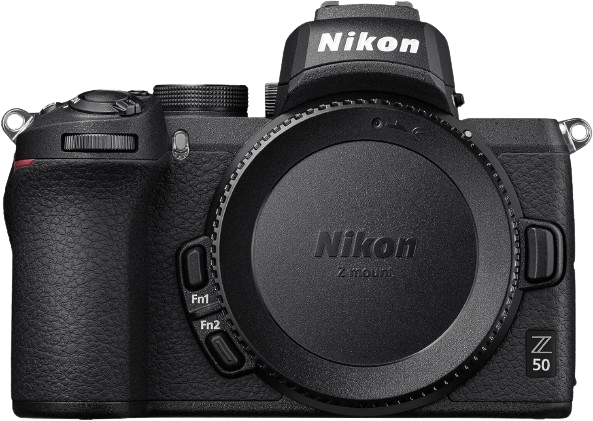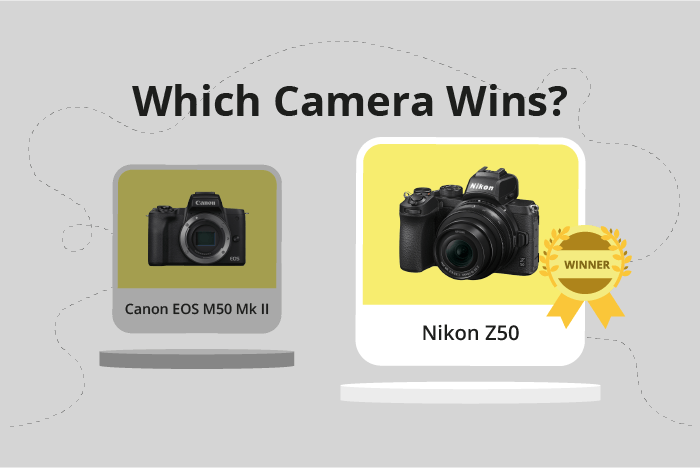Canon EOS M50 Mark II vs Nikon Z50 Comparison
Canon EOS M50 Mark II

Nikon Z50

The Nikon Z50 emerges as the winner with a score of 73/100, while the Canon EOS M50 Mark II trails behind at 59/100. Both cameras are mirrorless and were released just a year apart, with the Canon EOS M50 Mark II in 2020 and the Nikon Z50 in 2019. They have similar sizes, with the Nikon Z50 being slightly larger and heavier than the Canon EOS M50 Mark II.
The Nikon Z50’s higher score reflects its superior performance and features compared to the Canon EOS M50 Mark II. Despite being released a year earlier, the Nikon Z50 offers better value for its slightly higher launch price of $859, compared to the Canon EOS M50 Mark II’s $750.
However, the Canon EOS M50 Mark II is not without its merits. Its smaller size and lighter weight make it a more portable option for photographers on the go. Additionally, its lower launch price may appeal to budget-conscious consumers.
Taking these factors into account, the Nikon Z50 stands out as the better camera overall, delivering superior performance and features for a slightly higher price. Meanwhile, the Canon EOS M50 Mark II offers a more compact and budget-friendly option for those prioritizing portability and affordability.
Canon EOS M50 Mark II vs Nikon Z50 Overview and Optics
The Nikon Z50 outperforms the Canon EOS M50 Mark II in optics, with a score of 72/100 compared to Canon’s 59/100. Both cameras share several common specifications, including a CMOS sensor, APS-C sensor size, and the absence of image stabilization. However, the Nikon Z50 surpasses the Canon EOS M50 Mark II in certain areas, making it the winner in this comparison.
The Nikon Z50 has a higher DXOMARK score for its sensor, boasting a remarkable 97 compared to the Canon’s 58. This means the Nikon Z50 has a more advanced sensor, contributing to better image quality. Additionally, the Nikon Z50 features a faster shooting speed at 11 frames per second, compared to the Canon’s 10. This advantage allows the Nikon Z50 to capture action shots more effectively.
On the other hand, the Canon EOS M50 Mark II has a higher megapixel count at 24, compared to the Nikon Z50’s 21. This difference allows the Canon EOS M50 Mark II to capture slightly more detailed images. However, this advantage is not enough to outweigh the Nikon Z50’s superior sensor and faster shooting speed.
In terms of processors, the Nikon Z50 uses the Expeed 6 processor, while the Canon EOS M50 Mark II uses the Digic 8. Both processors are efficient, but the Expeed 6 in the Nikon Z50 contributes to the camera’s overall better performance in optics.
Considering these factors, the Nikon Z50 emerges as the better camera in terms of optics, thanks to its superior sensor and faster shooting speed. The Canon EOS M50 Mark II offers a slightly higher megapixel count, but it is not enough to surpass the Nikon Z50’s performance.
Canon EOS M50 Mark II vs Nikon Z50 Video Performance
The Canon EOS M50 Mark II and the Nikon Z50 both excel in video capabilities, with each camera earning a score of 91 out of 100. This tie showcases the strengths of both models in the realm of video recording.
Both cameras share several key video specifications. They each offer 4K maximum video resolution and 3840 x 2160 maximum video dimensions, ensuring high-quality, crisp footage. Additionally, they both support a maximum video frame rate of 120fps, providing smooth slow-motion capabilities. Furthermore, the Canon EOS M50 Mark II and the Nikon Z50 both have built-in time-lapse functionality, allowing for creative and dynamic video creations.
Despite the equal scores, the Canon EOS M50 Mark II has its unique advantages. However, since the scores are the same, these advantages must be weighed against those of the Nikon Z50 to determine which camera is truly better for video recording.
On the other hand, the Nikon Z50 also has its own strengths. Again, these must be compared to the Canon EOS M50 Mark II’s features to determine the better camera for video recording. Due to the equal scores, it is crucial to consider the specific needs and preferences of the user when choosing between these two cameras.
After examining the video capabilities of both the Canon EOS M50 Mark II and the Nikon Z50, it is clear that they are evenly matched. Both cameras boast impressive specifications and offer high-quality video recording options. Ultimately, the choice between these two cameras comes down to individual preferences and requirements, as the video capabilities are nearly identical.
Canon EOS M50 Mark II vs Nikon Z50 Features and Benefits
The Nikon Z50 emerges as the winner in the comparison of features, with a score of 86/100, whereas the Canon EOS M50 Mark II lags behind with a score of 70/100. Both cameras share several specifications, including a touchscreen, flip screen, lack of GPS, Wi-Fi, and Bluetooth connectivity.
The Nikon Z50 outperforms the Canon EOS M50 Mark II in terms of screen size, boasting a 3.2-inch screen compared to the Canon’s 3-inch screen. This larger screen size allows for easier framing and reviewing of photos, ultimately enhancing the user experience. Additionally, both cameras have a screen resolution of 1,040,000 dots, ensuring crisp and clear image previews.
In contrast, the Canon EOS M50 Mark II does not have any significant advantages over the Nikon Z50 in terms of features. Both cameras have the same screen resolution, Wi-Fi and Bluetooth capabilities, and lack GPS functionality. Despite the lower feature score, the Canon EOS M50 Mark II remains a viable option for photographers who prioritize other factors such as price or brand loyalty.
To conclude, the Nikon Z50 proves to be the superior camera in terms of features, with a larger screen size and a higher feature score. The Canon EOS M50 Mark II, however, remains a competent contender with similar specifications. Ultimately, the choice between these two cameras will depend on individual preferences and priorities.
Canon EOS M50 Mark II vs Nikon Z50 Storage and Battery
The Nikon Z50 outperforms the Canon EOS M50 Mark II in storage and battery with a score of 35/100, while the Canon scores 21/100. Both cameras have one memory card slot and accept SD, SDHC, and SDXC (UHS-I compatible) cards.
The Nikon Z50 offers a slightly longer battery life at 320 shots, compared to the Canon EOS M50 Mark II’s 305 shots. Additionally, the Nikon Z50 uses the EN-EL25 battery type and supports USB charging, making it more convenient for on-the-go users.
The Canon EOS M50 Mark II, on the other hand, uses the LP-E12 battery type and does not support USB charging. This lack of USB charging capability is a disadvantage compared to the Nikon Z50.
Considering the storage and battery aspects, the Nikon Z50 provides better battery life and the added convenience of USB charging, making it a more practical choice for photographers who need extended shooting time and flexible charging options.
Alternatives to the Canon EOS M50 Mark II and Nikon Z50
Are you still undecided about which camera is right for you? Have a look at these popular comparisons that feature the Canon EOS M50 Mark II or the Nikon Z50:

